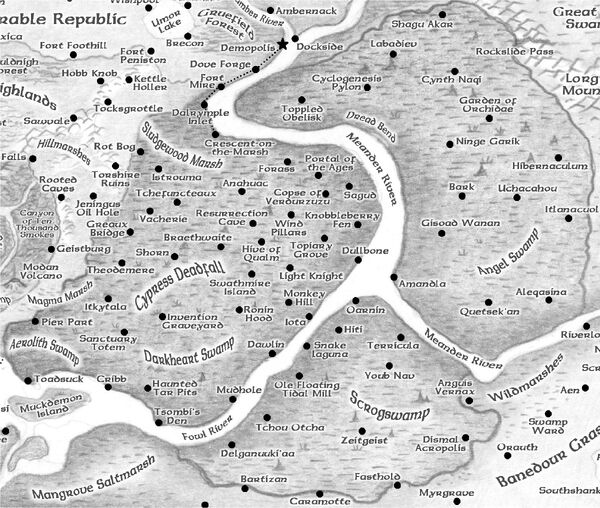The swamp was not always a swamp. Before the high time of necromancy several millennia ago, it was a vast plain of windswept grasses in the shadow of the mountains. Over time, the rivers shifted, forming an alluvial plain. A large forest grew, attracting wood elves and fey, orcs and arachnids, green dragons and woodcutters. This is the way the forest remained for thousands of years. Nearly 500 years ago, a great earthquake wracked the land, and Marais, the new god of the wetlands, was created. So powerful was the upheaval that the rivers ran uphill for a time, and lowered the alluvial plain several feet. A shallow valley formed and began collecting runoff from the Ophel Highlands, Agnathan Mountains, and Lorgrave Mountains, as well as backwash from Merganser Estuary. The estuary, freshets, bajada, alluvial plain, and river overflows merged, becoming the feared Dreadmire Swamp.

Dreadmire Swamp, without its surrounding lands.
The name of the swamp varies from culture to culture, the swamp is known by dozens of other names. Translated from the Aboriginine tongue, the human aborigines called it Elder Heath, a name created long before the swamp had festered its dense growth and deep mudflats. Local gnomes refer to it as the Misty Moors, their ancestral name for it. The swamp is generally called the Sinking Forest by the nearby elven population, Soggy Bottoms by the Bayou Halflings, Forlorn Swamp by the Mud Dwarves, and Monster Mire by the Thalass Emirate. It is known as Dismal Fen, Harsh Marsh, Wildwood Quag, and Cradle Swamp by River Ferriers, Heath Rangers, Mire Giants, and Quag Druids, respectively. The Hill Clans collectively refer to it as Mudflat Impasse. Since its largest neighbor is the Arable Republic, the most commen name used for the swamp is Dreadmire. Whatever you call it, it is both a lovely and dangerous place.
As any Quag Druid would tell you, not everything in the swamp is as horrible as the residents of local nations would have you believe. Kalendra Pickaxe, a Mud Dwarf, is just such a druid, and in her words, “Sure, Cradle Swamp is a dangerous place, but so are the mountains. There is much natural loveliness even in a harsh environment.” Kalendra is somewhat biased, surviving in a less hostile area of the swamp. A heath ranger, Dolo Lightwind, has another perspective, “I wish the farmers would understand that Wildwood Quag is a dichotomy, where on one hand it’s a refuge for dangerous creatures, and on the other it’s a forest of inestimable beauty and complexity, providing herbal cures and natural balance as a watershed for the entire region.” The halflings that dot the bayous of Dreadmire are of similar mind, although a bit more cautionary, “Da key ta livin’ off de Soggy Bottoms is ta be ‘ware of ya surroundin’ at all times,” says Goodeaux Undermarsh, “‘cause if ya stop too longs ta smell de water lilies, a monster eat ya every time.” All of the above inhabitants of Dreadmire, however, live in the Thicket, the more peaceful area of the swamp. It is undisputed that the Backswamp interior is deadly in the extreme, spawning unholy monsters never before seen even in the wildest natural lands.
Not much has been known by muka concerning the interior of Dreadmire, at least not until recently. A halfling professor from Excelsior College of Natural Studies, sage emeritus Professor Ineus Shortfellow, has recently produced a detailed and thorough compilation on the swamp and its surrounding wetlands. His book and accompanying hand-drawn maps are the culmination of nearly seventeen years of research and interviews with the Bayou Halflings, Marshfolk, Heath Rangers, Wild Elves, Quag Druids, Moor Knights, curious gnomes of the bordering hills, human Hill Clans, nearby Mountain Nomads, and even the unpredictable Lizardfolk. The tome is a magnum opus, as its title, "Cyclopedia of Swamp Environment and Cultures," reflects. The Dreadmire book was derived and paraphrased from that extensive work, and contains numerous insights and follow-up research based on fact, rumor, myth and revealed secrets of the swamp region. The Appendix section contains a direct excerpt from the manual.